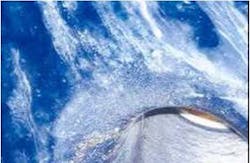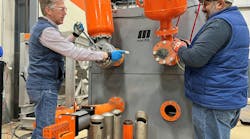Sterilization or sanitization procedures are typically meant to kill bacteria in a system. In addition, equipment is cleaned to remove residues from previous product batches and is subsequently flushed to remove cleaning liquids. But to ensure safe and efficient sterilization and cleaning, appropriate procedures aren’t enough. The right equipment improves cost efficiency, as well as patient safety.
Equipment must minimize contamination risk due to inappropriate product-contact surfaces. Machines shouldn’t introduce airborne particles and dust into the environment, nor entail risk of contamination from oil or other substances used. An operator cannot clean surfaces that can’t be reached.
The time, action, chemicals and temperature (TACT) circle originally developed by Sinner in 1960 shows the cleaning effects these parameters generate on equipment surfaces (see Figure 1) and the extent to which time, plus at least one more parameter, clean residues from a surface. If one parameter’s impact increases, others can be reduced.
For example, if you dip greasy hands in water, they won’t come clean. If put in a soap bath, hands are clean only after a long time. Raise soap bath temperature, however, and hands become clean more quickly. Rub your hands together, and they get shiny bright even faster.
Residue and product-contact surface determine the size, or impact, needed for cleaning. The most suitable chemicals and appropriate temperature are decided based on residue. High surface action lets chemicals and temperature work more efficiently, which makes possible reducing both, as well as cleaning time. Because the action is often built into the equipment design, the right equipment reduces cost and increases system cleanability.
Surface cleaning action is achieved by generating high velocity or cleaning fluids flow on all product-contact surfaces. Increased velocity also generates high turbulence and shear force on the surface, which ensures chemicals and temperatures reach deep into residues and dissolve or detach them safely and efficiently.
Testing TACT parameters
To test the influence of TACT parameters, the author designed a tank-cleaning test incorporating two tank-cleaning devices that generated different amounts of action. A static spray ball typically generates a wall shear stress of 2–5 Pa (i.e., falling film stress, depending on liquid temperature). A rotating jet head typically generates a wall shear stress of 40–1000 Pa (i.e., jet impingement, depending on jet pattern mesh).
To clean the tank sufficiently, two static spray balls operated for 48 minutes at a flow rate of 20 m3/h and a system pressure of 2.5 bar. One rotating jet head, however, achieved better results when it operated for 14 minutes at a flow rate of 6 m3/h and a system pressure of 5.0 bar (see Figures 2 and 3 and Table I).
The test showed that TACT circle theory works in practice. To clean a certain residue from a certain surface, TACT circle parameters can be adjusted for cost optimization (see Figure 3). With increased action, equal or better results were achieved in less time, and with reduced amounts of chemicals and heat. High shear forces can remove residues from most surfaces by themselves without chemicals or high temperatures. And it reduces cleaning chemical contamination risk while dramatically reducing cleaning costs.
Strong cleaning action on all product contact surfaces minimizes contamination and system malfunction risk, enabling cost-efficient cleaning. Common design pitfalls, however, impair equipment cleanability. Dead legs, pockets and crevices, air pockets and improper equipment surfaces are pitfalls too often seen in the pharmaceutical industry.
Design pitfalls
Dead legs. It is widely understood that dead legs should be avoided or minimized in a system. Some guidance states that the length to diameter (L/D) measurement for dead legs should not be more than two, and, in some cases, not more than three. The relation between the main-pipe velocity and the L/D measurement, however, is often overlooked. High main-pipe velocity makes the turbulence go deeper into the dead leg, and if the turbulence or action is strong enough, it will remove the residues at the bottom of the dead leg.
In a 1997 article, Haga et al. presented results from tests with various velocities in the main pipe in various L/D measurements. They found that for an L/D of six, it is possible to clean the residue adequately if the main-pipe velocity is higher than 1.5 m/s. They also found that for an L/D of three, it is impossible to remove the residue if the main pipe velocity is lower than 0.7 m/s (see Figure 4).
Pockets and crevices. No rule of thumb governs the pocket and crevice depth. Figure 5 shows a typical crevice found in pharmaceutical systems. Some say that crevices should be avoided or eliminated when possible, a statement that seems weak considering that a crevice could be likened to a dead leg with an L/D measurement of 50–100, compared with the normal 2–3. Following Haga et al., it would be impossible to achieve the velocity required to clean the bottom of a crevice. Thus, pockets and crevices should not exist in pharmaceutical systems because they always pose major contamination risk.
Air pockets. Air pockets are upside-down dead legs or crevices. Although residues do not collect in an air pocket, they stick to its surface. It is difficult to evacuate air from these pockets during cleaning, which means that the cleaning liquid will not reach the top of the air pocket and, accordingly, will not clean it. Air pockets must be eliminated or they introduce a high risk of contamination.
Surface finish. Surface finish is often considered a measurement of hygienic design. The maxim is that the smoother the surface, the more hygienic and easy to clean. But this principle is, in fact, open to debate. A 2003 study by Hilbert et al. tested adherence of bacteria to several surfaces and surface cleanability. The surfaces, from 0.1 μm electro-polished to 0.8 μm mechanically polished, showed no differences in adherence or cleanability. The main reason was the relatively large size of the individual bacteria compared with the small size of the surface imperfections. As long as the surface finish is below Ra 0.8–1.0 μm, the bacteria are too large to get trapped between the surface imperfections.
In another study, however, Riedewald showed that when bacteria accumulate in a biofilm, adherence and cleanability depend on the surface finish. It is hard for biofilm to attach to a smooth surface, and thus it is easy to detach them from such a surface.
The same is true for other sticky residues. A study at the Institute of Technology in Kolding, Denmark, tested cleanability of surfaces spiked with a yogurt solution that had been oven-dried (4). It clearly showed that a surface with a low Ra value was easier to clean than one with a high Ra value. The tested surfaces ranged from Ra 0.15 to 2.4 μm. Electropolished surfaces also were easier to clean than mechanically polished surfaces, which, in turn, are easier to clean than pickled surfaces.
Equipment designed correctly will avoid the above pitfalls, thus facilitating safe and cost-efficient cleaning. The more cleaning action is applied on all product-contact surfaces, the easier, safer and quicker system cleaning will be.
About Alfa Laval
Alfa Laval is a leading global provider of specialized products and engineering solutions based on its key technologies of heat transfer, separation and fluid handling. Alfa Laval’s worldwide organization works closely with customers in nearly 100 countries and, in 2011, posted annual sales of about SEK 28.6 billion (approx. 3.2 billion Euros).


